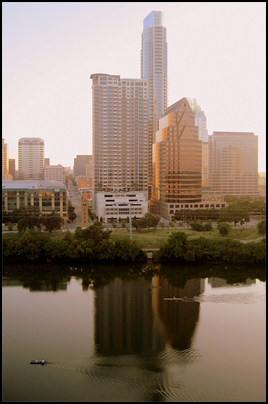
Partly because it is in a state of creative revival, Austin, TX, is in a special, perhaps a unique, position to show the world how a city can end homelessness. We referred to the plan created by Richard R. Troxell of House the Homeless. Now his latest published work is in the March issue of The Progressive Populist, and it’s called “Restore opportunity with a Living Wage.”
What makes Austin so wonderful? A place can be remarkable for a while, then become ordinary. Despite many changes over the years, Austin somehow still retains the cachet of cool. When a writer of Michael Ventura’s caliber makes a place home, you know it’s got something going for it. There are countless excellent visual artists and all kinds of other creative people in and around Austin, and, of course, the legendary music scene.
The music history of Austin is nothing short of awesome, in the original, non-cliche sense of the word. From the long-gone Armadillo World Headquarters to the amazing SXSW festival, those factors and a thousand more have made it the music capital of the Southwest, and a world-class music town.
There is another Richard, whose last name is Florida. His book, The Rise of the Creative Class, chose only two places as examples of the top-level creative city, one across the Atlantic (Dublin, Ireland) and one in the USA, namely, Austin. Florida goes into great detail about how Austin exerted itself to “build the kind of habitat required to compete and win in the Creative Age.” In his view, the three legs on which Austin’s superiority rest are the cultural scene, the high-tech industrial (nerd) sector, and the music scene. He writes:
Austin includes traditional nerdistan developments to the north, lifestyle centers for cycling and outdoor activities, and a revitalizing university/downtown community centered on vibrant Sixth Street, the warehouse district, and the music scene.
In researching his book, Florida spoke with several people for whom relocating to or staying in Austin was the most important factor when they made a job decision. One informant said:
I can have a life in Austin.
Back in the autumn of 2009, journalist Marc Savlov interviewed people experiencing homelessness, who are as likely as housed people to be the victims of street crime. If predators are among the homeless, other street people are the easiest prey to catch. Some interviewees expressed regret that hardcore boozers and addicts give everybody a bad name. An informant known as J. D. said:
One thing that would really help decrease the numbers of homeless in Austin is if the city could try to raise public awareness of the fact that there’s a difference between ‘crackheads and alcoholics’ and ‘homeless people.’
Austin struggles with the same issues as any other city, because the homeless are everywhere. Sometimes the reactions are illogical. Savlov says:
Tackling the homelessness issue while trying to find a way to improve quality of life for everybody — housed and houseless alike — is tantamount, as virtually everyone interviewed for this article can attest, to saddling a Hydra.
The journalist explored some of the issues that plague the city, and talked about the Great Streets Program, described as:
… an urban redevelopment effort that would include widening of sidewalks for cafe-style dining, abundant shade-producing trees lining the streets, and a higher concentration of mixed-use retail space alongside existing bars and music venues… While not specifically an anti-crime measure, Great Streets brings in more people at leisure — and a higher number of people is a natural deterrent to crimes of opportunity.
With all due respect, something is left out here. The implication is that crime is only prevented when “people at leisure,” i.e., housed people who are relaxing from their jobs, are out and about. But the homeless occupy urban spaces too. Having them around, as some of the ears and eyes making up that “natural deterrent to crimes,” can’t be such a bad thing.
Cities are shared with the homeless, whether the housed people like the situation or not. In the profound words of a bumper sticker, “It is what it is.” And starting from there, it can change if we change some of our ways of thinking about it.
Ace Backwords points out, in Surviving on the Streets, that street people perform the valuable service of utilizing some of the material goods that would otherwise go to the landfill. By recycling some of the detritus of a wasteful society, the homeless help to reduce our collective guilt over squandering the earth’s resources. Backwords makes another point:
The nocturnal life… can be seen as a public service that we perform to help alleviate the crowdedness of city life. We’ve volunteered to go on the night shift…
Another thing Richard Florida said is, members of the Creative Class choose Austin because:
What they look for in communities are abundant high-quality amenities and experiences, an openness to diversity of all kinds, and above all else the opportunity to validate their identities as creative people.
So, let’s think about high-quality amenities, not just for the folks lucky enough to be employed in high-tech jobs, but for everybody. Openness to diversity means just that, and some of the diverse kinds of people to be found in this city, like any other, are people experiencing homelessness.
Now, here’s the biggie. All the creative people of Austin have a splendid opportunity to validate their creative identities by figuring out this homeless situation in such a way that it will set a shining example to the rest of the world, as the city has already done in so many other ways. If any place is up to the challenge, Austin is.
Reactions?
Source: “How to end homelessness in Austin: A plan,” CultureMap Austin, 02/08/12
Source: “Restore Opportunity with a Living Wage,” Populist.com, 03/01/12
Source: “Overview,” CreativeClass.com, 2004
Source: “Faces of Homelessness,” The Austin Chronicle, 10/09/09
Image by StuSeeger (Stuart Seeger), used under its Creative Commons license.


